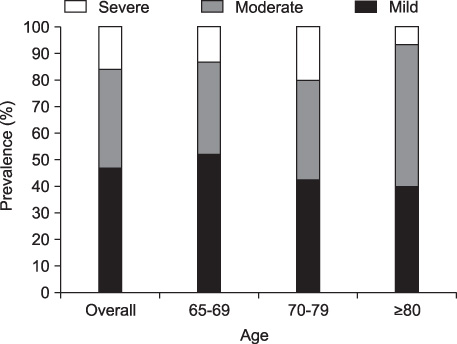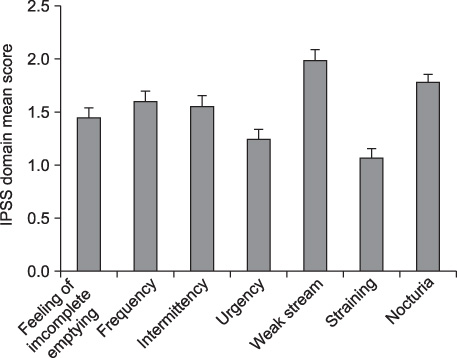Korean J Urol.
2009 Sep;50(9):843-847.
The Prevalence of Benign Prostatic Hyperplasia in Elderly Men in Korea: A Community-Based Study
- Affiliations
-
- 1Department of Urology, Dongguk University Ilsan Hospital, Goyang, Korea.
- 2Department of Urology, Seoul National University Bundang Hospital, Seongnam, Korea. ssbyun@snubh.org
- 3Department of Pathology, Seoul National University Bundang Hospital, Seongnam, Korea.
Abstract
- PURPOSE
The incidence of benign prostatic hyperplasia (BPH) is increasing in Korea. However, there are few reports about the prevalence of BPH in elderly men in Korea. We report the prevalence of BPH in elderly men through a community-based study. MATERIALS AND METHODS: We collected data from the Korean Longitudinal Study on Health and Aging (KLoSHA), which was designed as a population-based, prospective study in populations aged>65 years living in Seongnam, Korea. We selected 301 male participants by random sampling. The selected participants were interviewed with the International Prostate Symptom Score (IPSS) questionnaire and were evaluated by physical examination, blood tests, and transrectal ultrasound. The number of analyzed subjects was 236. The definition of BPH was a combination of moderate (8-19) to severe (>19) IPSS and prostate enlargement (>30 g on transrectal ultrasound). RESULTS: The prevalence of BPH was 40% overall and 36% in men in their late 60s (65-69 years), 43% in men in their 70s (70-79 years), and 53% in men over 80 (> or =80 years). BPH prevalence increased according to age but showed no statistically significant differences among the groups (p>0.05). CONCLUSIONS: The overall prevalence of BPH in this study was 40%, which was higher than in other previous epidemiologic studies in Korea. This study suggests an increasing tendency of BPH prevalence in Korea.
Keyword
MeSH Terms
Figure
Reference
-
1. Berry SJ, Coffey DS, Walsh PC, Ewing LL. The development of human benign prostatic hyperplasia with age. J Urol. 1984. 132:474–479.2. Garraway WM, Collins GN, Lee RJ. High prevalence of benign prostatic hypertrophy in the community. Lancet. 1991. 338:469–471.3. Lee ES, Yoo KY, Kim Y, Shin Y, Lee C. Prevalence of lower urinary tract symptoms in Korean men in a community-based study. Eur Urol. 1998. 33:17–21.4. Chung TG, Chung J, Lee MS, Ahn H. Prevalence of benign prostatic hyperplasia in Jeong-Eup Area: community-based study. Korean J Urol. 1999. 40:52–58.5. Rhew HY, Koo JH, Cho SS, Kang JS, Lee CK, Kim JC, et al. The prevalence of BPH in Busan city over age 40. Korean J Urol. 2001. 42:223–227.6. KIm KI, Chang HJ, Cho YS, Youn TJ, Chung WY, Chae IH, et al. Current status and characteristics of hypertension control in community resident elderly Korean people: data from a Korean longitudinal study on health and aging (KLoSHa study). Hypertens Res. 2008. 31:97–105.7. Barry MJ, Fowler FJ Jr, O'Leary MP, Bruskewitz RC, Holtgrewe HL, Mebust WK, et al. The American Urological Association symptom index for benign prostatic hyperplasia. The Measurement Committee of the American Urological Association. J Urol. 1992. 148:1549–1557.8. Bosch JL, Kranse R, van Mastrigt R, Schröder FH. Reasons for the weak correlation between prostate volume and urethral resistance parameters in patients with prostatism. J Urol. 1995. 153:689–693.9. Blanker MH, Groeneveld FP, Prins A, Bernsen RM, Bohnen AM, Bosch JL. Strong effects of definition and nonresponse bias on prevalence rates of clinical benign prostatic hyperplasia: the Krimpen study of male urogenital tract problems and general health status. BJU Int. 2000. 85:665–671.10. Sarma AV, Wei JT, Jacobson DJ, Dunn RL, Roberts RO, Girman CJ, et al. Comparison of lower urinary tract symptom severity and associated bother between community-dwelling black and white men: the Olmsted County Study of Urinary Symptoms and Health Status and the Flint Men's Health Study. Urology. 2003. 61:1086–1091.11. Cho KS, Jo MK, Lim D, Son H, Park SK, Yoo KY, et al. Epidemiologic survey using International Prostate Symptom Score (I-PSS) of lower urinary tract symptoms (LUTS) in elderly men above 40 years old in Seoul area. Korean J Urol. 2001. 42:840–848.
- Full Text Links
- Actions
-
Cited
- CITED
-
- Close
- Share
- Similar articles
-
- Benign Prostatic Hyperplasia in Community-Dwelling Elderly in Korea
- The Prevalence of Benign Prostatic Hyperplasia in Elderly Men in Korea: A Community-Based Study
- Estimation of Benign Prostatic Hyperplasia Prevalence in Korea: An Epidemiological Survey Using International Prostatic Symptom Score(IPSS) in Yonchon County
- The Effects of Abdominal Obesity on the Increased Prevalence Rate of Hypertension and Diabetes Mellitus in Benign Prostatic Hyperplasia Patients
- A Prominently Large Glans penis as a Possible sign of Benign Prostatic Hyperplasia



